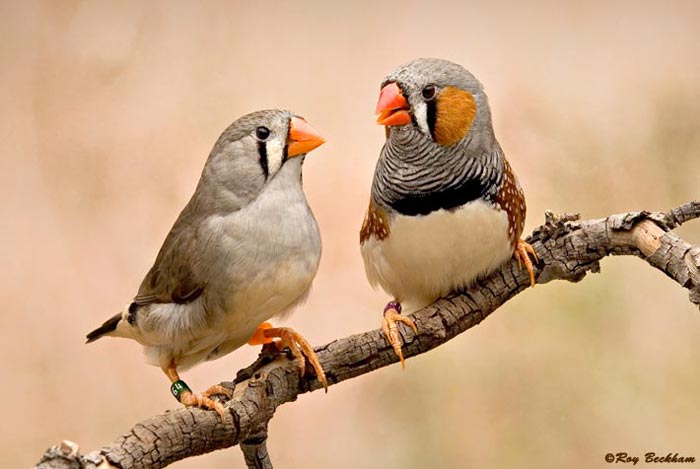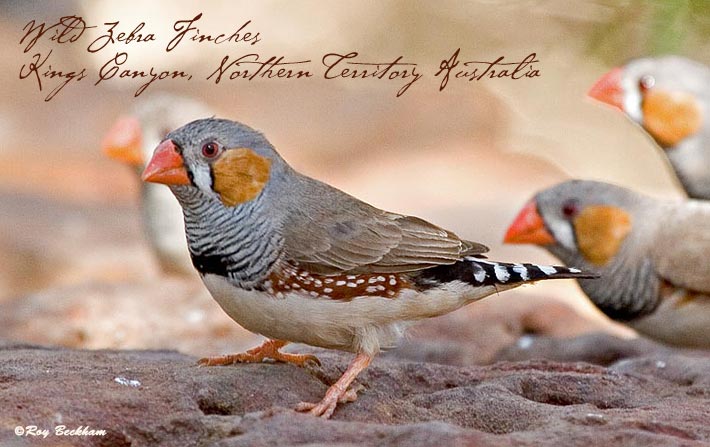




 |
|
|||||||||||||||||||||
 |
|
|
|
|
|
|
|
|
|
|||||||||||||
|
|
|
|
|
|
||||||||||||||||||
|
|
|
|
|
|
|
|
|
|
||||||||||||||
|
|
|
|
|
|
||||||||||||||||||
|
|
|
|
|
|
|
|
|
|
||||||||||||||
|
|
|
|
|
|
||||||||||||||||||
|
|
|
|
|
|
|
 |
|
|||||||||||||||
 |
 |
|
||||||||||||||||||||
|
|
|
|
||||||||||||||||||||
|
|
|
|
|
|
|
|
|
|
|
|
|
|
|
|
|
|
|
|
|
|
|
|
| Zebra Finch - Taeniopygia guttata castanotis | |||||
 |
|||||
| Zebra Finches - Male (right) and female (left) | |||||
|
Common Names Description There are a number of mutations that can alter these colors and dimorphic characteristics. See the individual pages on the specific color mutations for descriptions of the altered colors and how that effects the sexing of the birds. Diet Breeder's Notes Zebras will nest in just about anything they can stick their bodies into. Breeders have used finch boxes with half open and hole entrances, baskets, both open and closed types, milk cartons and tin cans. Anything will do for the Zebra finch. I prefer to use a standard wooden finch box. I have a design with a half moon opening at the top, but also use half open fronts for many of the pairs. Some cages have an external nest box that the breeding pair enters through a hole in the cage. I usually place saw dust in the bottom of the nest box and then place some straw and/or fine grasses in the box in the rough shape of a nest. This just gives the pair a head start on the nest and if they are not spectacular nest builders, something to lay their eggs in. I then offer a variety of other materials for them to fine tune their nest to their likeing. I often provide coco fiber, jute fiber or strands and some feathers. Given enough material, the Zebras will build their nest to the entrance hole. They like to look out of the nest while incubating eggs (CFW hen in nest). Once laying has started though, the material should be removed since Zebras are notorious for building sandwich nests. That is a layer upon layer of completed nests and clutches of eggs. The average clutch will consist of 4-7 small white eggs laid at the rate of one per day. Incubation will usually begin in earnest after the third or fourth egg is laid. Both sexes share in the incubation duties with one relieving the other to feed and drink and then both remaining in the nest at night. The eggs will begin to hatch after 12 or 13 days (chicks hatching), depending upon how tightly the pair sat during incubation. The chicks hatch out with light colored fuzz on the body which is usually dark skinned, but can vary depending upon the color or mutation of the young (see gape markings of nestlings). The young grow rapidly and are feathered by 16 days (Clutch of chicks Approx 16 days) and will begin to venture out of the nest starting at around 18 days of age (Fledgling male). The males can often be identified by the whiter rump feathers. The young are fed for an additional 14-21 days with the male taking on much of that duty towards the end. By the time the young are weaned the parents will have likely started another clutch of eggs and are chasing off the young. This chasing can sometimes seem merciless, but the young are rarely seriously harmed. If the young are independent and the parents are chasing the young, they should be removed or they will likely be heavily feather plucked. I usually remove the eggs of the second clutch if the young are not ready to be moved. It's better to let the parents rest a little between clutches rather than taxing them with repeated clutches so close to each other. I usually will take no more than 3-4 clutches from a breeding pair before giving them a rest. They are fully capable of raising clutches non-stop for years, but the resulting young are substandard and the adults are worn out. Besides, I have usually raised all that I will need from that pair within those few clutches anyway. Although it has been shown that Zebra finches can raise their young on substantially lower protein levels than most finches, it is best to provide some form of complete protein while they are raising young. There is a marked improvement in size and vigor of the young that are produced. I find that my egg food mix (Roy's egg food) is suficient to meet their needs, but any egg food that is high in egg content should be fine. If you feed leafy greens, be sure that the pair is actually eating all that you provide and not using in for nesting material. They will take just about anything into the nest when they are determined to builed more and the wilted greens may rot and mold in the nest or they will cover the eggs with it. For more information on breeding Zebra finches and associated problems, see the Breeding section. Additional Notes The Zebra finch is like the 'white lab rat' of the finch world. No other finch has been studied as closely or had as much written about them as the Zebra finch. There are numerous studies of wild Zebras in their natural environment as well as laboratory studies of song learning, imprinting and mate selection to name just a few. There have been studies to determine how long these desert adapted finches can survive without water. The longest study was 1-1/2 years. The late Dr. Luis Baptista of the San Francisco Academy of Science also conducted a study on water deprivation with Zebras and told me that he gave up after 1 year and gave the birds water because he felt sorry for them, but was confident that they could have survived for a much longer period without water. They survived on metabolic water alone. However, Zebras cannot survive a single day without food. Also, don't call me if you deprive your favorite Zebra finch of water and it dies. The studies were valid, but they also incurred some losses. Zebra finch males learn their song from song tutors, usually that is their father or the male that feeds them. There is a basic framework to their song, but during their sensitive phase they will learn and add notes and change the song to create their own. Zebra males that are fostered under Society finches will pick up the song of the Society male and incorporate notes and to some extent the rhythm of the Society song onto the Zebra song framework. They can also pick up notes from unrelated species in their environment. I borrowed a Zebra male that had been raised in the presence of Ringneck Pheasants and his song had the normal rhythm, but had the squawk of the pheasant incorporated into his song. The Zebra finch will hybridize with a number of different species. Although they are often kept in mixed colonies, they rarely will choose a mate outside of their species. The only exception to this would be the Timor Zebra finch, a subspecies of the Australian Zebra finch. These will readily hybridize and should not be housed together. Timor Zebras are still rather rare in American aviculture so this is really only of concern to breeders of the Timor species. Those hybrids are fertile. The Australian Zebra has been hybridized with Owl finches, their closest relative and Society finches, another very common domesticated finch just to name a few. Those hybrids with other species are infertile. Zebra finches can be used for fostering other species. The more closely the species is related to the Zebra finch, the more likely they will be successful in raising that species. Owl finch hatchlings are nearly identical in appearance to Zebra finch hatchlings. They only way to distinguish the two is by mouth markings. For some Zebras used as fosters though, this may be enough for them to reject any Owl finches that are mixed with their own. Therefore, it is advisable not to mix species or ages of chicks that you wish the Zebra finch to foster. A 1 cent stamp from Australia featured the Zebra finch. (click to view stamp). The Zebra finch is the most popular finch in aviculture and is second only to the Canary and the Budgerigar as the most popular cage bird. |

Wild Zebra finch male
Color Varieties (click each variety to learn more)
Fawn
Chestnut Flanked White (CFW)
Lightback
Pied
Black Breasted
Orange Breasted
Black Cheek
Recessive Silver
Penguin
White
Florida Fancy
Isabel
Dominant Silver
Black Face
Fawn Cheek/Gray Cheek
Crested
Yellow Beak
Eumo
Agate (These were imported, but not well established. They may still be around)
Timor Zebra (T. guttata guttata) - The only subspecies of Australian Zebra finch
Other mutations not yet available in the United States.
Isabel (Australia) Very similar to the US Florida Fancy
George (Australia)
Slate (Australia) Very similar to US Recessive Silver
Grizzle (Australia)
Black Front (Australia)
Charcoal (Australia)
